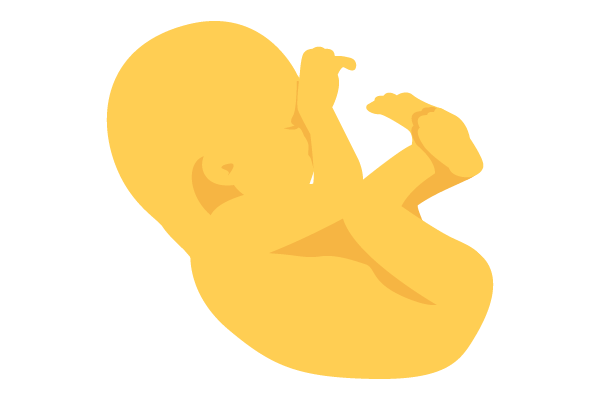
32 weeks pregnant
For information about weeks 32 to 35 of a twin or multiple pregnancy, tap here.
With every day that passes, Baby is closer and closer to joining your family! And your little one is working on some very important tasks right now, like rotating into their birthing position and maybe even sucking their thumb.
How’s Baby?
As Baby keeps getting closer and closer to being born, they now measure in at 17-18 inches, are the size of a pomelo, and weigh about 4.3 pounds. Your little one’s head also has a coating of fuzz, and their skin is continuing to fill out. Baby is still a little ways away from their first mani-pedi, but they already do have a full set of fingernails and toenails! In fact, one of your baby’s favorite activities right now is sucking their fingers, which is not only cute, but actually improves their coordination and familiarizes them with their body.
And Baby is really practicing for the big stage, breathing and “swimming” like crazy. Your baby is also probably already in the head down position with their head moving closer to your pelvis as they prepare for delivery.
What's new with you?
This late in your pregnancy, you know your own unique symptoms pretty well. Symptoms are different for every pregnant person, but one of the most common symptoms of the third trimester is the increased need to pee. Hemorrhoids, flatulence, and constipation might continue as well. And you’ve probably reached a peak in the increased blood flow that’s, by now, been contributing to any number of symptoms. That extra 50% of blood does have a purpose though — currently it’s helping to keep Baby snug and safe, and it’s also going to help make up for the blood you lose in delivery.
It’s also time to start thinking more about your hopes and plans for labor and delivery, including thinking about if you may want to use any pain management. Talk to your provider about your options and what makes most sense for you. Epidural anesthesia is among the most common pain management options, though many opt for other medications, or elect to have medication-free births. It is also possible to labor without analgesics (pain meds) but need other medications like pitocin and/or antibiotics. Ask your provider about the pain management options available to you and any other questions you have about labor and delivery. It does help to go into labor with an understanding of your options, but keep in mind that you can always ask more questions even when in labor if you change your mind then. Everyone’s desires and needs are different, and your provider and care team will help you do what’s best for you.
It’s also important to prepare for life after delivery — you want to be as prepared as you can be for Baby’s arrival, since you’ll be busy with your little one before you know it. If you’ve finished with some of your baby prep basics — Crib? Check! Diapers? Check! — and want another project to keep you busy as you count down the days to your little one’s arrival, it’s never too early to start with some baby-proofing. Putting up baby gates, getting some cabinet locks and door knob covers, and mounting furniture (like dressers, changing tables, or bookcases that can tip over) to the wall so it’s not a fall hazard are all items that can be added to your baby-proofing to-do list, whether now or later. Certainly, Baby is several months away from trying to climb dressers or explore under the kitchen sink, but if you have some extra time to do some of this prep now, you'll be glad to have dealt with any potential safety hazards long before your little one is particularly mobile.
Reviewed by the Ovia Health Clinical Team
Read more
Sources
- "Lesson 10: Fetal Positions and Adaptations." Brookside Press. Brookside Associates Medical Education Division. https://brooksidepress.org/ob_newborn_care_1/?page_id=97.
- “Common discomforts of pregnancy.” March of Dimes. March of Dimes. May 2016. https://www.marchofdimes.org/pregnancy/common-discomforts-of-pregnancy.aspx.
- Mark A Curran, M.D. “Fetal Development.” Perinatology.com. Perinatology.com. March 31, 2019. https://www.perinatology.com/Reference/Fetal%20development.htm#1.




